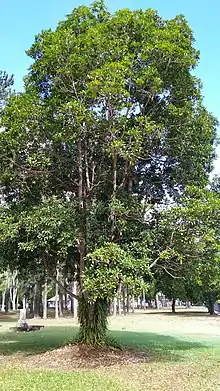Elaeocarpus bancroftii
Elaeocarpus bancroftii is a tree in the family Elaeocarpaceae native to Queensland in Australia. Common names include Kuranda quandong, Johnstone River almond, ebony heart, grey nut, and nut tree.[1]
| Elaeocarpus bancroftii | |
|---|---|
 | |
| Scientific classification | |
| Kingdom: | Plantae |
| Clade: | Tracheophytes |
| Clade: | Angiosperms |
| Clade: | Eudicots |
| Clade: | Rosids |
| Order: | Oxalidales |
| Family: | Elaeocarpaceae |
| Genus: | Elaeocarpus |
| Species: | E. bancroftii |
| Binomial name | |
| Elaeocarpus bancroftii | |
Taxonomy
The species was first formally described by botanists Ferdinand von Mueller and Frederick Manson Bailey in 1886, based on plant material collected on the Johnstone River.[2]
Description
E. bancroftii is a tree growing up to 30 m (98 ft) and a bole diameter of 60 cm (24 in)[3][4] with bushy dark green foliage. Like many other trees in the genus, the leaves turn bright red before falling.[1][5] The flowers are large and showy,[5] occurring from March to June,[6] and are followed by large, dull grey/green, globular drupes about 30–40 mm (1.2–1.6 in) in diameter containing a single seed with a very hard, thick endocarp.[1][3]
Range
E. bancroftii is endemic to north east Queensland, growing in well developed rainforest from near Cooktown southwards to about Tully and from near sea level to 1,200 m (3,900 ft).[1]
Uses and Cultivation
Australian aborigines ate the seeds, although the very hard shell required them to use stones to crack them open. These special "nut stones" were sometimes left under the tree.[1] The 1889 book 'The Useful Native Plants of Australia' records that "The cotyledons or 'kernels' have a good flavour, and are eaten by the settlers. Other species of Elaeocarpus have fruits which are more or less useful in this respect. Johnstone River, Queensland."[7] Fallen fruits are also eaten by cassowaries and the seeds are eaten by native rats,[3] (notably the Giant White-tailed Rat, Uromys caudimaculatus), after chewing its way through the hard shell.
Gallery
References
- "Australian Tropical Rainforest Plants Edition 7 (RFK7)". Australian National Botanic Gardens. Retrieved 13 September 2020.
- "Australian Plant Name Index (APNI)". Retrieved 13 September 2020.
- Cooper, William; Cooper, Wendy (1994). Fruits of the Rainforest - A Guide to Fruits in Australian Tropical Rain Forests. GEO Productions. p. 108. ISBN 0646198033.
- "Useful Tropical Plants". Retrieved 13 September 2020.
- "Leaf Whispering in the Tropics". Retrieved 13 September 2020.
- Jones, David L. (1986). Rainforest Plants of Australia. Reed Books. p. 141. ISBN 0730103811.
- J. H. Maiden (1889). The useful native plants of Australia : Including Tasmania. Turner and Henderson, Sydney.
- "Lake Devon Nursery". Retrieved 13 September 2020.
- "Fairhill Native Plants". Retrieved 13 September 2020.


